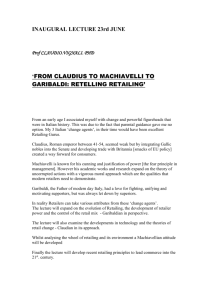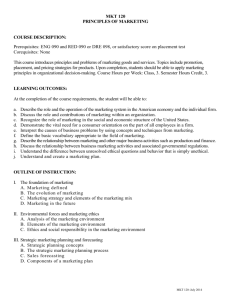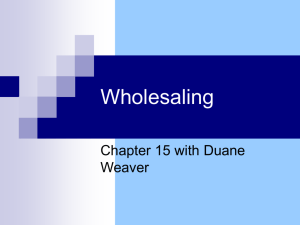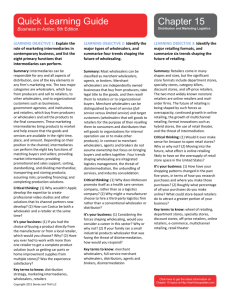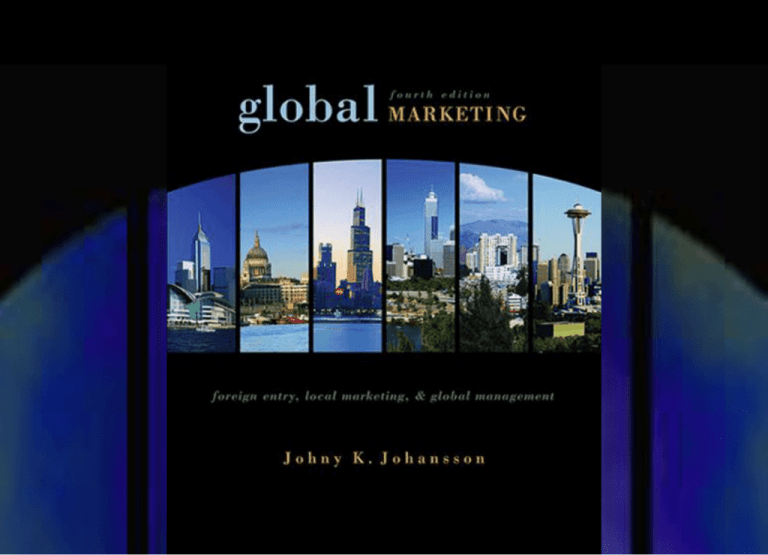
Chapter
15
Global Distribution
McGraw-Hill/Irwin
© 2006 The McGraw-Hill Companies, Inc. All rights reserved.
Outline
Rationalizing Local Distribution Channels
Global Wholesaling
Global Retailing
Channel Actions against Gray Trade
Global Channel Design
Takeaways.
Rationalizing Local Channels
Changing Distributors
The distribution channel configuration for entry into a
foreign markets is rarely optimal once the product is
established on the market
The traditional reason for termination of a distributor is
The exporting firm finds that the distributor is not doing a
good enough job in the market
Multiple Channels (Parallel Distribution)
Channel changes do not necessarily involve termination of
contracts
In some cases multiple channels emerge or are created
Exclusive and Dual Distribution
EXCLUSIVE DISTRIBUTION
DUAL DISTRIBUTION
EXPORTER
INDEPENDENT LOCAL
DISTRIBUTOR
EXPORTER
INDEPENDENT LOCAL
DISTRIBUTOR
OEM BUYER
RETAILERS
RETAILERS
RETAILERS
The PLC Effect:
How Local Channels Evolve
LOW
MARKET
GROWTH
RATE
HIGH
INTRODUCTORY
DECLINING
--PC’s: HOBBYIST STORES
--PC’s: MAIL ORDER
--DESIGNER APPAREL:
BOUTIQUES
--DESIGNER APPAREL:
OFF-PRICE STORES
GROWING
MATURE
--PC’s: SPECIALITY
RETAILERS
--PC’s: MASS
MERCHANDISERS
--DESIGNER APPAREL:
BETTER DEPARTMENT
STORES
--DESIGNER APPAREL:
MASS
MERCHANDISERS
Determinants of Channel Choice
1. Product Requirements
(Perishable lettuce, sensitive apples, fine china, scratched cars,
beer without freshness, moldy cakes,...)
2. Logistic Feasibility
(Equipment by DHL, autos by air, faxes of newsletters, freezer
railroad cars, shock-absorbent packaging, vacuum-packed,...)
3. Demand Factors
(Importance of speed for repairs, timing of raw materials for
inventory, customers’ need for immediate gratification, quality
standards of middleman and final user,...)
Determinants of Channel Choice
4. Competitive Factors
(How fast is fast? How good is good?
What are the alternatives for the buyer?
Strategic importance of the market?)
5. Middlemen Resources
(Storage capability? Credit or consignment or cash? Motivating with
fast delivery?
Just-in-time system? Promised supplies?
Ability to support the marketing effort?)
6. Own Resources
(Financial, manpower, production capacity)
Wholesaling
Wholesaling Functions
Primary functions of wholesaling
Making contact
Negotiating
Buying
Selling
Warehousing
Wholesaling is a major component of a country’s infrastructure
and its structure reveals important clues as to the country’s
stage of development
Wholesaling in Selected Countries
Belgium
Denmark
Greece
France
Ireland
Italy
Luxembourg
Netherlands
Portugal
United
Kingdom
United States
Japan
Number of
enterprises
(thousands)
48.0
35.8
28.0
132.4
3.5
192.6
1.9
71.9
31.3
142.7
Persons employed
(thousands)
Turnover
(billions ECU)
201.8
166.2
115.4
1,049.0
40.4
1084.0
10.8
360.0
200.0
921.0
85.0
60.0
—
312.0
12.0
—
5.0
135.0
—
310.0
469.5
436.4
4,578.0
4,332.0
1,260.0
2,651.0
Rationalizing distribution:
Italian Pasta in Japan
Conventional Route
Small
wholesaler
Producer
Import
agent
Processing
and
packing plant
Primary
wholesaler
Intermediary
wholesaler
Retail price: 170yen/300g package
Retailer
Restructured Route
Producer
Savings: 25%
Importing
company
A/C
Processing
and
packing plant
Retail price: 128yen/300g package
Depots
Distribution
Wholesalers
Distribution
centers
Retailer
Wholesaling
Full-service wholesalers can usually be counted on in most
countries
However, because of their size and tie-ins with existing brands
and chains they might not be willing to distribute the firm’s
products
The full-service concept should be carefully assessed for each
country entered, since a full-service wholesaler will retain market
knowledge and control the marketing.
For the experienced entrant, limited services wholesalers
might be more beneficial, because of increased control and
more management learning.
Wholesalers and Power
Power and Competition
The size distribution of wholesalers in many countries
approximates the well-known “80-20” rule
80 percent of the transactions are handled by 20 percent of
the firms
Efficiency
The trend toward integration is based on the technological
developments that have make large-scale economies and
technical coordination feasible
These vertically and horizontally integrated firms become
gate-keepers to the local market – entry barriers.
Retailing
• Retailers are the middlemen who buy from wholesalers and
manufacturers and sell directly to the ultimate consumer.
•The retailing structure involves stores (supermarkets, department
stores, specialty stores) as well as banks, restaurants, mail-order,
etc.
•Different economies have different retail structures (e.g. Gillette
blades are sold through drugstores in the US, tobacco shops in
Italy, department stores in Germany, on the street in Moscow, at
movie counters in Thailand, & from traveling vans in India)
Retail Outlets in Selected Countries
Belgium
Denmark
Greece
France
Ireland
Italy
Luxembourg
Netherlands
Portugal
United Kingdom
United States
Japan
Number of
enterprises
(thousands)
Persons
employed
(thousands)
Turnover
(billions
ECU)
127.8
48.1
175.0
461.8
29.3
929.7
3.5
95.0
173.3
348.2
1,503.6
1,619.8
274.7
199.7
338.2
2,090.0
131.4
2,401.0
18.1
637.5
366.3
3,030.0
19,085.0
6,851.0
35.0
24.0
20.0
260.0
11.0
230.0
3.0
45.0
20.0
280.0
1,350.0
682.0
Retailing
Retailing and Lifestyles
The retailing structure has to adapt to the varying living conditions
(the lifestyles) of individual households
Creating New Channels
As economic growth takes place and global trade expands, new
alternatives emerge
Global Retailing
The logistical and operational know-how of leading retailers is
helping to increase the trend of retailing being globalized at a fast rate
The rapid deployment of point-of-purchase information technology
has shifted the power in the channel toward large retailers
World’s Largest Retailers
based on sales for the year 2000
Rank
1
2
3
4
5
6
7
8
9
10
Company
Wal-Mart
Carrefour
Kroger
Home Depot
Metro
Ahold
Kmart*
Albertson's
Sears, Roebuck
Target
Country
US
France
US
US
Germany
Netherlands
US
US
US
US
Sector
Discount Store/Warehouse club
Hypermarket
Supermarket
Home Improvement
Diversified
Supermarket/Hypermarket
Discount Store/Specialty
Supermarket
Department Store/General Merchandise
Discount Store/Department Store
($ millions)
180787
59690
49000
45738
42733
41251
37028
36762
36548
36362
*as of March 2002, Kmart was in bankruptcy proceedings Source: Chain Store Age 12/2001
Global Retailing?
• Global expansion of retailing is still difficult. Most
large retailers are still pre-dominantly domestic.
• The Body Shop is one success story. The factors that
helped its global expansion include:
• 1. STANDARDIZED PRODUCTS, GLOBAL BRAND
• 2. GLOBAL SEGMENTS
• 3. A STRONG STORE “CONCEPT”
• 4. CONCEPT MOBILITY
• 5. SIMILAR INFRASTRUCTURE (REPLICABILITY)
Global Logistics
GLOBAL LOGISTICS – the transportation & storage
activities necessary to transfer the physical product from
the manufacturing plants & warehouses in different
countries to various local market countries
Nowadays, global distribution has been consolidated such
that fully integrated transportation from point to point
across the world is possible at low cost.
Transportation as a Trade Barrier
Transportation was traditionally one of the strongest trade
barriers. Not so any more, because of increased efficiency:
1. SEAMLESS: FROM TRUCK TO TRAIN TO SHIP
2. CONSOLIDATION OF TRANSPORTATION AND
WAREHOUSING
3. EXPRESS SERVICES (FedEx, UPS, DHL)
4. RESULT: LOGISTICS ARE OFTEN OUTSOURCED
AND NOT A GREAT TRADE BARRIER ANYMORE.
Global Logistics
Air Express
Technical innovations in computerized inventory systems and
numerically controlled machines for good handling made
possible the growth of air express systems
Ocean Carriers
For shipments of bulky and low-value-per-unit products
Ocean vessels are still the most economical carrier alternative
overseas
There have been a number of global carrier alliances in the
shipping industry due to the savings involved in sharing resources
and the advantage in providing integrated one-stop services to the
shipper
Global Logistics
Overland Transportation
The increasing volume of international trade has put the inland
distribution system under pressure
One North American solution has been the roll-on-roll-off system
in which a loaded container is simply rolled onto a railcar and
shipped by rail for part of the way, avoiding congested freeways
Warehousing
The competitive need on the part of global companies to be
“close to the customer” and provide fast and efficient service
This places increased demand on warehousing and inventory
management
Parallel Distribution & Gray Trade
GRAY TRADE - parallel distribution on genuine goods by
intermediaries other than authorized channel members
Three main factors motivate entrepreneurs to engage in gray
trade:
1. Wide price discrepancies between national markets
2. Limited availability of certain models or versions in one
market
3. Inexpensive logistics means that transportation can be
accomplished with relative ease
The Gray Trade Arbitrage
USA
home ($)
Germany
(DM)
Japan
(Yen)
If DM/$ = 1.8, and Yen/$ = 120, then buy at home
If DM/$ > 1.8, and Yen/$ = 120, then buy in Germany
If DM/$ < 1.8, and Yen/$ > 120, buy in Japan
Seiko’s Channels of Distribution
Europe
Hong Kong
Japan
North America
Importer
Importer
Importer
Distributors
Distributors
Distributors
Distributors
Retailers
Retailers
Retailers
Retailers
Broken arrows denote the flow of Seiko watches through unauthorized channels of distribution.
Solid arrows denote the flow of Seiko watches through authorized channels of distribution.
Effects of Gray Trade
EROSION OF BRAND EQUITY
can happen if the gray goods do not perform to the level
expected
STRAINED RELATIONSHIPS WITH AUTHORIZED
CHANNEL MEMBERS
arises when channel members face intra-brand competition
LEGAL LIABILITIES
usually involves warranties that can’t be honored
COMPLICATION OF GLOBAL MARKETING
STRATEGIES
forecasted sales in a market may not be realized when
there is a sudden influx of gray goods
Channel Actions against Gray Trade
Supply Interference
Engaging in relationship building with distributors and requesting the
careful screening of orders and careful disposal of surplus inventory
Dealer Interference
Searching for gray imports at the gray traders’ outlets in the importing
country, then asking the dealer to help dispose of the inventory
Demand Interference
Using advertising to educate customers about the drawbacks of gray goods
Strategic Attack
Creating stronger reasons for customers to patronize authorized dealers
Global Channel Design
Two major considerations:
What type of channel/middlemen should be used to ensure
that the strategic marketing objectives are met in that
country?
What are the important functions in the channel network for
that country?
Designing Global Channels
REVISIT YOUR FSA’S
Key success factors and FSA’s vary across countries and across
channels
WHAT CHANNELS ARE AVAILABLE?
Once you identify the critical features of your channel network, find
out if the country market possesses these channels
CHANNEL TIE-UP
Channel members might be difficult to enlist due to entry barriers,
competition, and special trade allowances
COORDINATION & CONTROL
Once a distribution network is established, coordination & control
from a centralized headquarters should be feasible
Takeaway
The wholesale & retail structure of a local market reflects the
country’s culture & economic progress & the way business is
done in that country, but new channel modes may be
successful if timing & conditions are right.
Takeaway
Channel management is a matter of local execution.
Local subsidiary managers need to play important roles in
implementing any global distribution strategy.
Takeaway
Global logistics & transportation are important determinants
of financial performance, and their efficiency has been
improving dramatically.
Takeaway
Parallel distribution & gray trade create control problems for
the global firm & resellers, and they can be managed through
close cooperation with local distributors in key markets.
Takeaway
The creation of globally coordinated channels has to start
with a clear understanding of how the firm-specific
advantages depend on distribution channel design.


